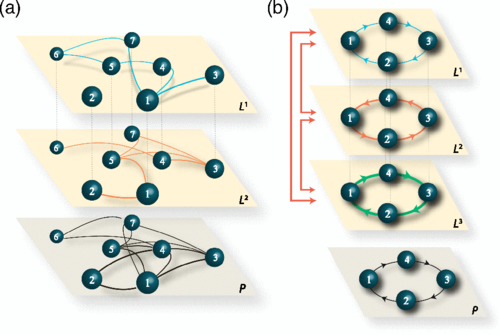Identifying the hidden multiplex architecture of complex systems

Su invito del Prof. Vito Latora, giorno 12 giugno 2019, con inizio alle ore 15:00, presso l'Aula F del DFA, il Dr Luca Lacasa (School of Mathematical Sciences, Queen Mary University of London, London, UK) terrà un seminario dal titolo: Identifying the hidden multiplex architecture of complex systems (or a new decomposition theory of non-Markovian dynamics). Tutti gli interessati sono invitati a partecipare.
Abstract. Elements composing complex systems usually interact in several different ways and as such the interaction architecture is well modelled by a network with multiple layers –a multiplex network–. However only in a few cases can such multi-layered architecture be empirically observed, as one usually only has experimental access to such structure from an aggregated projection. A fundamental challenge is thus to determine whether the hidden underlying architecture of complex systems is better modelled as a single interaction layer or results from the aggregation and interplay of multiple layers.
Assuming a prior of intralayer Markovian diffusion, in this talk I will present a method [1] that, using local information provided by a random walker navigating the aggregated network, is able possible to determine in a robust manner whether these dynamics can be more accurately represented by a single layer or they are better explained by a (hidden) multiplex structure. In the latter case, I will also provide a Bayesian method to estimate the most probable number of hidden layers and the model parameters, thereby fully reconstructing its hidden architecture. The whole methodology enables to decipher the underlying multiplex architecture of complex systems by exploiting the non- Markovian signatures on the statistics of a single random walk on the aggregated network.
In fact, the mathematical formalism presented here extends above and beyond detection of physical layers in networked complex systems, as it provides a principled solution for the optimal decomposition and projection of complex, non-Markovian dynamics into a Markov switching combination of diffusive modes.
I will validate the proposed methodology with numerical simulations of both (i) random walks navigating hidden multiplex networks (thereby reconstructing the true hidden architecture) and (ii) Markovian and non-Markovian continuous stochastic processes (thereby
reconstructing an effective multiplex decomposition where each layer accounts for a different diffusive mode). I will also state two existence theorems guaranteeing that an exact reconstruction of the dynamics in terms of these hidden jump-Markov models is
always possible for arbitrary finite-order Markovian and fully non-Markovian processes. Finally, using experiments, I will apply the methodology to understand the dynamics of RNA polymerases at the single-molecule level.